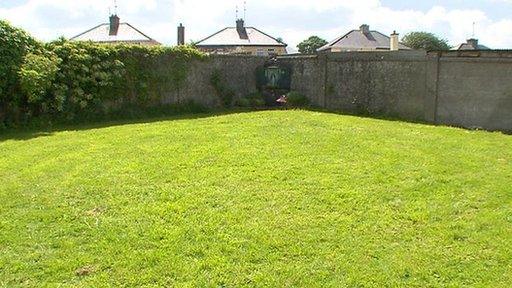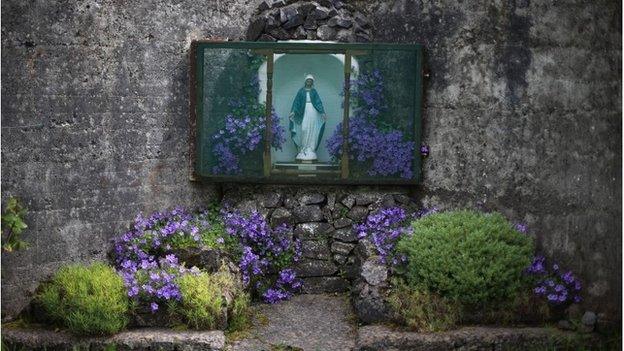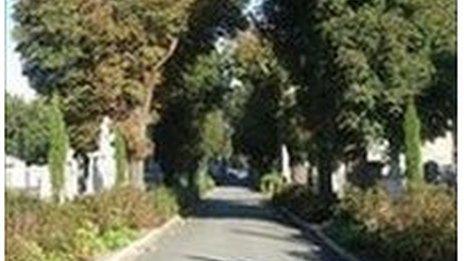Tuam babies: Justice minister orders police report
- Published

The remains of the children were found at the home in Tuam
The Irish justice minister has ordered a police report on all the information it has on the deaths of almost 800 children at a mother and baby home.
The remains of some children, aged between two days and nine years, were found in a concrete tank in County Galway.
They died between 1925 and 1961. The grave in Tuam was found 40 years ago, but was thought to date from the 1850s.
Amnesty International has joined calls for an investigation.
The Irish government has set up an inter-departmental group to look at the case.
Justice Minister Frances Fitzgerald said decisions about criminal investigations fall to be considered by An Garda Siochána (the Irish police).
She said her department had been liaising with them.
"The purpose of criminal investigations is to lead to the prosecution of persons where the commission of offences has been established," she said.
"Consideration will be given by government on how best to proceed in the interests of all those who were affected by extremely disturbing events."
Earlier, Taoiseach (Irish prime minister) Enda Kenny said he wanted to know exactly what the scale of the situation in Tuam was and whether there were similar mass graves at other sites around the country.
Mr Kenny said he asked Minister for Children Charlie Flanagan to draw together a number of officials to see what was involved and whether it was an isolated incident.
He said a decision would then be taken in terms of what was the best thing to do to deal with "yet another element of our country's past".
He said he understood the situation had been known about since 1972 and there were Dáil records relating to inspections dating back to the 1930s.
The human rights organisation, Amnesty International, said any investigation must consider whether ill-treatment, neglect or other abuses were factors in the children's deaths.
"A thorough investigation must be carried out into how these children died and if ill-treatment, neglect or other human rights abuses factored into their deaths," said John Dalhuisen of Amnesty.
'Shocked'
"We also need to know why these children were not afforded the respect of a proper and dignified burial.
"The Irish government must not view this and other cases as merely historic and beyond its human rights obligations."
The organisation added that the Tuam case should not be viewed in isolation, and called on the government to investigate allegations of ill-treatment of women and children in other homes.
On Thursday, Catholic Archbishop of Tuam Michael Neary said he was "greatly shocked" by the news, adding that the church had no records about the burial.
The home was run by nuns of the Bon Secours Sisters for 36 years.
In a statement, Bon Secours said it handed its records to the state after it closed its doors.
"In 1961 the home was closed. All records were returned to the local authority, and would now be within the Health Service Executive, County Galway," the order said.
The nuns said they were committed to engaging with Catherine Corless, the historian who identified the extent of the burials, and the Tuam graveyard committee, which is seeking a permanent memorial at the site.
They have welcomed the government's announcement of an investigation into what happened.
RTE journalist Philip Boucher-Hayes said some people in Tuam, who have been trying to raise money to erect a plaque in memory of the children, were relieved that the story is now getting media attention.
However, he said others in the town were embarrassed.
'Communal graves'
He said: "Talk to anybody else and there's a bit of hand wringing, there's a bit of chest beating and a lot of 'ah sure, those were the times, weren't they, what's the point in going and unearthing it now'.
"And I think that that is an embarrassment about our past that is probably replicated in so many places where there were industrial schools, where there where mother and baby homes and where there is now the suspicion in Cork, in west Meath, in Tipperary that there are very, very large communal graves of unmarked bodies, unknown about, un-commemorated, discarded bodies."
He said maps showed that the area where the Tuam remains were found had been sewage tank that became disused in the 1930s after it began to leak.
He said he had spoken to people who remembered seeing nuns "in the failing light of summer evenings, quite late in the evening, burying remains with workmen into this septic tank site".
"There is a wealth of evidence there which points towards the nuns knowingly burying hundreds of bodies in a disused septic tank," he said.
The Tuam home was one of 10 institutions in which about 35,000 unmarried pregnant women - so-called fallen women - are thought to have been sent.
The children of these women were denied baptism and segregated from others at school. If they died at such facilities, they were also denied a Christian burial.
County Galway death records showed that most of the children buried in the unmarked grave had died of sickness or malnutrition.
Catholic broadcaster Fr Brian D'Arcy said the discovery was shocking.
Speaking to Newstalk radio in the Republic of Ireland, he said: "When I heard it first, I really began to think that this was some atrocity that had happened in a foreign country or remnants of a famine in some other country or a bad regime, because that's what it sounds like.
"It's just a dreadful, horrible thing and I simply couldn't believe that it was in my own lifetime as it were, happening in the country and in the same religion to which I belong to and have professed all my life."
He said it was a "kind of hypocrisy" - both religious and political - that "keeps popping up from that era".
"It's the kind of thing that says that some children are very valuable while, at the same time, it seems to have been this massive thing that children from unmarried mothers were not valuable."
Two years ago, Irish justice minister Alan Shatter said he was considering calls for an investigation of a former Protestant-run Bethany Home in Dublin.
Up to 219 children born at the mother and baby home between 1922 and 1949 died.
In 2010, 40 infants from the home were discovered in unmarked graves in the nearby Mount Jerome cemetery.
- Published6 June 2014

- Published5 June 2014

- Published3 February 2012

- Published4 June 2014

- Published3 June 2014